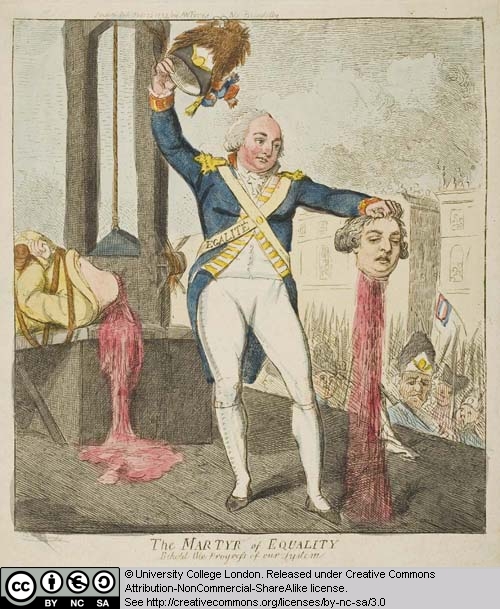9 The Martyr of Equality

Isaac Cruikshank (1756
– 1811)
The Martyr of
Equality, Behold the Progress of Our System , 1793
Etching with
hand-colouring
Published by S.W.
Fores, No.3 Piccadilly,
This caricature represents the execution of King Louis XVI in
1793. Louis was condemned and sentenced to death by the National Convention on
January 17 1793. Four days later, on 21 January he was executed by guillotine
in a public spectacle attended by cheering crowds. In Isaac Cruikshank’s
caricature, published less than a month after Louis XVI’s death, the focus is
not only on the gruesome execution by guillotine, but also on Louis XVI’s
cousin, the former Duke of Orleans. He was one of the signatories who condemned
Louis to death and stands to the side of the guillotine holding the head of
Louis. The title, The Martyr of Equality, is a pun on the Duke’s new
revolutionary name, Philippe
Egalité.
Despite the initial sympathy of many of the British people
to the French Revolution, as the political violence increased in 1792 and 1793,
during the September Massacres and the Terror, the British Establishment began
to fear that vicious revolutionary tendencies might spread to their own
country. Prints began to reflect a negative attitude towards the Revolution.
The liberty cap, an icon used frequently in early pro-revolutionary propaganda
to reflect the new Republic, was replaced by the frightening guillotine as the
predominant symbol of the French Revolution after the execution of Louis XVI in
1793. Images of the guillotine in use were issued in their thousands in
Licensed under the Creative Commons Attribution Non-commercial Share Alike 3.0 License
This resource has been released as an open educational resource (OER) on a Creative Commons 'Attribution Non-commercial Share Alike' license. This means that once downloaded, content can be modified and improved to complement a particular course. This requires, however, that improvements are recycled back into the OER community. All content present at the time of download must be accordingly credited and, in turn, novel content must be appropriately licensed.